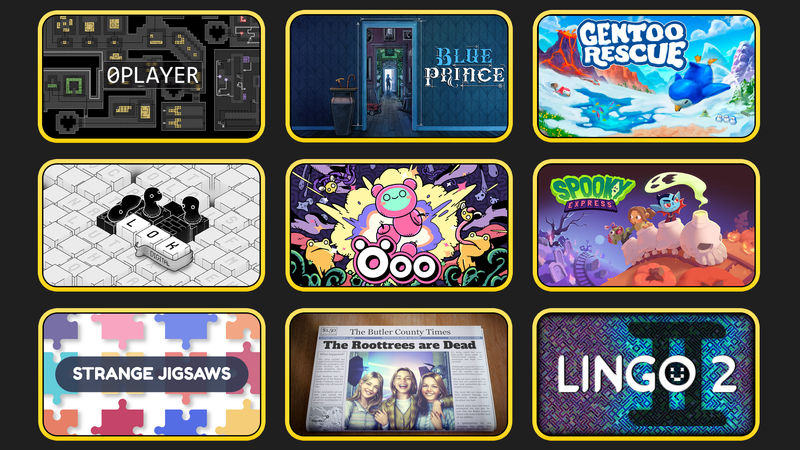When solo developer Julia Minamata set out to make a graphic adventure game inspired by old Sierra titles like The Dagger of Amon Ra and King’s Quest, she had two goals in mind. “My first goal was to give people who are nostalgic for the genre that feeling again,” says Minamata. “My number two thing was to reach people who didn’t play these games back in the day, who don’t have this nostalgia.” To pull it off—and after finishing The Crimson Diamond in one five-hour sitting despite zero experience with its inspirations, I can say she pulled it off without a hitch—Minamata knew she had to welcome players in. “It’s a cozy mystery by genre, but I also wanted it to be cozy by design.”
The Crimson Diamond puts you in the role of Nancy Maple, a plucky geologist sent to rural Ontario in search of diamonds. The conspiracies that unfold among the tenants of Crimson Lodge are navigated via text parser, an old-school control scheme that Minamata knew early on would present a barrier to new players. Every action must be deliberately written in the form of a text command, from the opening of a door to the dusting, collecting, and examination of fingerprints, so players need to explore and attend carefully to solve puzzles that emerge from the game’s evocative 16-color world. Cataloging each lodgers’ shoe sizes might require a combination of memory and cunning, while other challenges send you searching your surroundings for makeshift tools. Sometimes the way forward is formulaic, but more often it demands your ingenuity.
Scenarios are sometimes exacting, and Minamata wanted to encourage players to be specific about their intent rather than spamming guesses into the parser. Luckily, with a novel’s worth of rich description and more than 850 unique commands, whatever you come up with has a good chance of working. “When I can see a player’s face light up when they see that I’ve anticipated something that they try,” says Minamata, “it’s completely priceless.” For example, one puzzle asks the player to melt a lump of wax. This can be done over a candle flame, on a stovetop, or even by makeshift double boiler.
That might sound out-of-genre for fans of games like King’s Quest. Puzzles in those games typically required players to find just the right combination of phrasing and positioning to progress. An unrecognizable smattering of pixels may in fact be a vital clue. Deaths came quickly and randomly, sometimes even on the first screen. “When I thought about making my own game, I thought about what I loved about those games,” Minamata recounts. “But I also thought about what I didn’t like so much about those games, and one of those things was how mean they were.” Adversity defined many early adventure games, but Minamata knew she needed to respect the attention of modern players if they were going to reach any of the game’s endings.
The Crimson Diamond still keeps those hallmark Sierra deaths as a kind of collectible—special kill screens that the player has every opportunity to anticipate in advance—but otherwise it’s difficult to completely halt Nancy’s forward progress. As far as puzzles go, the design supports multiple styles of play in addition to multiple solutions. You’re never rushed if you want to think a puzzle through yourself, but Crimson Lodge is also full of helpful characters who are willing to talk it out. I came to rely on the housekeeper’s encyclopedic knowledge of the lodge, and Nancy herself isn’t shy about offering ideas and encouragement, either. “It’s you and her on this adventure together,” says Minamata, harkening back to the willingness of Sierra protagonists to wander into crocodile-infested moats at the player’s say-so. Try something like that in The Crimson Diamond, and Nancy will at least object.
And there’s one more voice ready to cheer the player on: Minamata herself. Prominently featured in the pause menu is a link to the game’s official hintbook, a free chapter-by-chapter compilation of nudges and solutions. You could attempt a playthrough without using the hintbook, but it’s worth keeping open if only for Minamata’s amiable writing. I usually feel disappointed whenever I have to click a “hint” button, but The Crimson Diamond’s hintbook oozes enthusiasm. Each section concludes with a section on everything you might have missed outside of the critical path, from useful items to easter eggs, adding depth beyond and around each puzzle.
As Nancy departs from the town of Crimson in the game’s epilogue, she’s nagged by intrusive thoughts of any mysteries still unsolved. But at the player’s request, she’ll kindly keep them to herself. There may be many ways forward, but the game isn’t interested in judging which path you choose.
It’s impossible to feel unsupported while playing The Crimson Diamond, despite its remote setting. The player is joined by Nancy and Minamata, the game bending—but never breaking—to accommodate every playstyle and well-reasoned solution. “When there are multiple solutions to a problem, it does a couple of things,” says Minamata. For one, it accommodates all players and all styles of thinking. But it also embeds players in the setting. “That, I think, increases that magical feeling of this just being a world that makes sense. And if you try to perform an action that makes sense to solve something, then you might get a solution.”
Tune into Julia Minamata’s Twitch channel on Tuesdays at 8 p.m. EST, where she works on art for upcoming projects. Fingers crossed that will include the next Maple mystery before long. In the meantime, go play this one if you haven’t.









